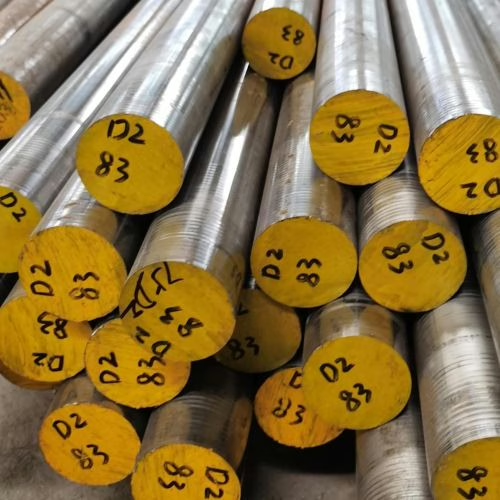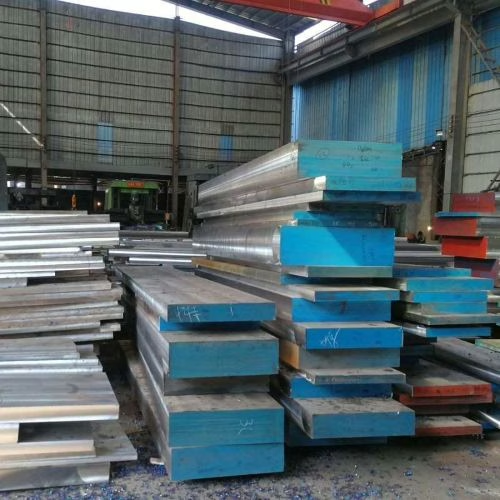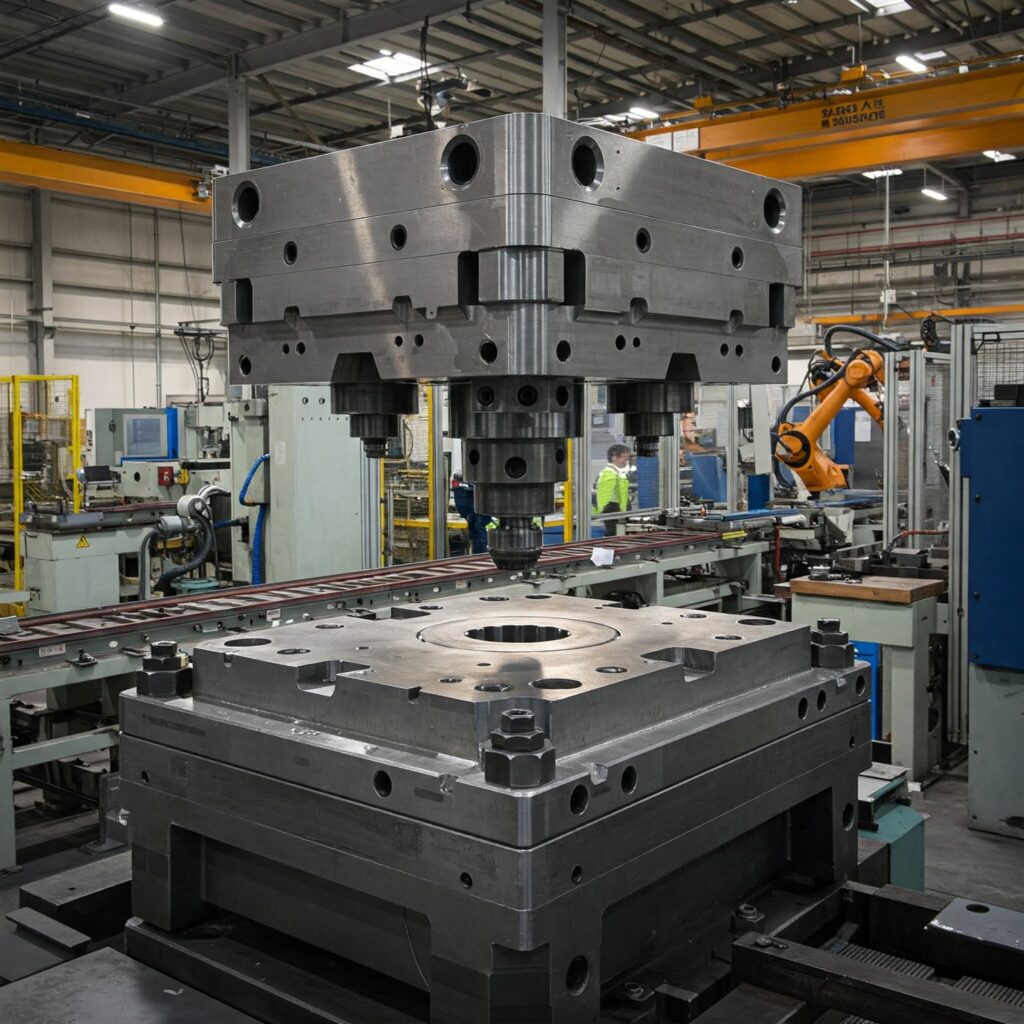الوقت المقدر للقراءة: 7 دقائق
النقاط الرئيسية
- D2 steel is a high-carbon, high-chromium cold-work tool steel, while 4140 is a medium-carbon, low-alloy structural steel.
- D2 offers exceptional wear resistance and high hardness (60-62 HRC), yet has limited toughness compared to 4140.
- 4140 steel provides a good balance of strength and toughness, making it suitable for parts under dynamic loads.
- Key applications include D2 for cutting tools and dies, and 4140 for automotive components and drive shafts.
- Choose D2 for wear resistance and dimensional stability; opt for 4140 for strength and toughness.
الفولاذ D2 مقابل 4140: فولاذ الأدوات D2 و فولاذ 4140 كلاهما عبارة عن سبائك حديدية مهمة، لكنهما ينتميان إلى تصنيفات مختلفة ومصممان لتطبيقات مميزة، حيث يتمتعان بخصائص فريدة ويتطلبان معالجات حرارية محددة.
D2 steel is a high-carbon, high-chromium cold-work tool steel. It belongs to the D-series tool steels, which are specifically designed for manufacturing tools, dies, and punches used under demanding conditions for cutting, forming, or machining other materials. Primarily employed for cold work applications, D2 steel typically operates below 200°C, often at room temperature. Among all high-carbon, high-chromium tool steels, D2 stands as a highly significant and representative grade.
AISI 4140 steel is a medium-carbon, low-alloy structural steel, also known as construction steel. Its most significant value lies in the balance between strength and toughness. It is a chromium-molybdenum (Cr-Mo) steel, often grouped with other ultra-high-strength steels such as 4130 and 4340. Although 4140 is highly popular in manufacturing and tooling, it is not classified as tool steel. It is typically supplied in forms such as bars and plates, and achieves specific mechanical properties through heat treatment, making it well-suited for manufacturing high-strength shaft components. It is essential to note that this type of low-alloy steel is not suitable for withstanding high temperatures.


تعبير
The properties of D2 steel are determined by its high carbon and high chromium content. The substantial presence of these two elements results in the formation of a large quantity of extremely hard chromium-rich carbides within the steel. 4140 steel, on the other hand, is a medium-carbon alloy steel. Its primary alloying elements are chromium (Cr) and molybdenum (Mo). Molybdenum is particularly crucial in 4140 steel, as it ensures the development of an ideal, fine microstructure after heat treatment. This microstructure is key to achieving the balance of strength and toughness characteristic of 4140 steel.
| العنصر | فولاذ الأدوات D2 (%) | فولاذ 4140 (%) |
| الكربون (C) | 1.40 – 1.60 | 0.38 – 0.43 |
| الكروم (Cr) | 11.00 – 13.00 | 0.80 – 1.10 |
| الموليبدينوم (Mo) | 0.70 – 1.20 | 0.15 – 0.25 |
| المنجنيز (Mn) | 0.10 – 0.60 | 0.75 – 1.00 |
| الفاناديوم (V) | 0.50 – 1.10 | – |
| السيليكون (Si) | 0.10 – 0.60 | 0.15 – 0.35 |
| الفوسفور (P) | ≤ 0.03 | ≤ 0.035 |
| الكبريت (S) | ≤ 0.03 | ≤ 0.040 |
الخصائص الميكانيكية
The primary advantage of D2 lies in its exceptional wear resistance. Its high carbon and high chromium composition forms a large number of hard carbides in the microstructure. D2 exhibits extremely high hardness, typically reaching 60 to 62 HRC (Rockwell hardness). 4140 steel can also achieve high strength and hardness through heat treatment, but its hardness values vary significantly depending on the tempering temperature. While it can attain high surface hardness in specific applications (such as nitriding), this is not its core strength.
Compared to D2, one advantage of 4140 is that it strikes a good balance between strength and toughness, making it well-suited for parts subjected to dynamic loads. D2 exhibits moderate toughness and is relatively brittle, especially when compared to specialized impact-resistant steels. While D2 can be used for long-lasting production tools, its limited toughness often leads to its application as an “insert” embedded within a tougher die body, rather than as a standalone component subjected to significant impact.
In terms of absolute load-bearing capacity, the difference between the two is substantial. 4140 Steel: When properly heat-treated, 4140 achieves exceptionally high strength. Ultimate Tensile Strength (UTS): Up to 1965 MPa; Yield Strength: Up to 1740 MPa. This high-strength characteristic, combined with its resistance to torsion and reverse stresses, makes it ideal for manufacturing components like drive shafts. In its standard tempered state, D2’s strength is substantially lower than that of heat-treated 4140. Ultimate tensile strength (UTS) is approximately 758 MPa; yield strength is approximately 411 MPa. D2’s primary characteristic is wear resistance, notwithstanding extreme structural loads.
- صلابة. صلابة الفولاذ D2 تتراوح صلابة الفولاذ 4140 بين 60 و62 HRC بعد المعالجة الحرارية. على الرغم من أن الفولاذ 4140 يتمتع بصلابة عالية من خلال المعالجة الحرارية، إلا أنها أقل من صلابة الفولاذ D2. تتراوح صلابة الفولاذ 4140 المُخمَّد والمُقسّى بين 235 و578 HB، حسب درجة حرارة المعالجة.
- قابلية التصلبD2 فولاذ مُقَسّى بالهواء، أي يُمكن تقسيته بالتبريد في الهواء، مما يُقلل التشوه. يتميز فولاذ 4140 بصلابة متوسطة. مع أنه يُمكن تقسيته بالهواء في قطاعات رقيقة، إلا أنه عادةً ما يُخَمَّد بالزيت عمليًا للتصليد التام.
- الصلابةيتميز فولاذ D2 بمتانة ضعيفة. مع ذلك، يتمتع فولاذ 4140 بمتانة أفضل. تتأثر خصائص متانته بدرجة حرارة المعالجة؛ على سبيل المثال، عادةً ما يُتجنب المعالجة بين 230 و370 درجة مئوية (450 إلى 700 درجة فهرنهايت) لمنع الهشاشة الزرقاء.
- مقاومة التآكل. D2 steel has extremely high wear resistance, higher than that of 4140 steel. 4140 Steel can significantly improve its wear resistance through surface hardening treatments such as nitriding or induction hardening.
- قابلية التصنيع. إن D2 لديه قابلية تصنيع ضعيفة، مع تصنيف قابلية تصنيع يبلغ 45، مقارنة بالفولاذ الكربوني 1%، والذي تم تصنيفه عند 100. يتمتع 4140 بقابلية تصنيع جيدة، وخاصة الإصدارات المعاد كبريتها مثل SAE 1140.
- ثبات الأبعاديتعرض فولاذ D2 لتشوهات طفيفة أثناء المعالجة الحرارية. عند تبريده بالهواء، يتمدد أو ينكمش بمعدل 0.0005 بوصة لكل بوصة (0.0005 مم/مم). يتميز فولاذ 4140 بثبات أبعاد جيد بشكل عام، ولكنه، كغيره من أنواع الفولاذ، عرضة للتشوهات أثناء التبريد، خاصةً مع ارتفاع نسبة الكربون فيه، مما قد يزيد من احتمالية التشقق.
Fabrication and Heat Treatment
D2 is an air-hardening tool steel that achieves high hardness through air cooling, exhibiting minimal dimensional changes and deformation during the heat treatment process. Consequently, D2 is suitable for high-precision mold manufacturing. 4140 steel undergoes heat treatment through quenching and tempering. To achieve high strength, it is typically oil-quenched, followed by tempering within a broad temperature range of 205°C to 705°C, to precisely attain the desired strength and toughness.
D2 steel is tough to machine and grind. Its high carbon content and significant chromium content result in poor machinability. 4140, on the other hand, is much easier to machine. Additionally, grades like SAE 41L40, which incorporate added sulfur (S), are available on the market and offer improved machinability even in hardened conditions.
D2 and 4140 steel are both challenging to weld due to their high carbon content and significant carbide content in their microstructure, making conventional welding methods challenging.
التطبيقات
The selection between D2 and 4140 is guided entirely by the intended function, specifically whether the part needs maximum surface abrasion resistance or maximum bulk strength and toughness.
يُعد فولاذ D2 مناسبًا للتطبيقات التي تتطلب إنتاجًا طويل الأمد، ومقاومة عالية للتآكل، وثباتًا في الأبعاد. تشمل تطبيقاته الشائعة أدوات وقوالب القطع والختم، وقوالب وأدوات التثقيب، وعمليات التشكيل، وأدوات التشذيب.
فولاذ 4140 هو فولاذ هندسي متعدد الاستخدامات، مناسب للمكونات التي تتطلب صلابة متوسطة وقوة وصلابة جيدتين. تشمل تطبيقاته الرئيسية أعمدة الدفع، وأعمدة مكونات السيارات عالية الأحمال، والتروس في التطبيقات الحرجة، ومكونات محركات السيارات عالية الأحمال.
| درجة الفولاذ | Key Application Attributes | Examples of Use |
| فولاذ D2 | Excellent wear resistance; Long-run capability; Dimensional stability; Cold-work operations. | Shafting, gears, axles, crank shafts, machine parts, highly loaded gearing, cold-headed/cold-forged fasteners, and core material for nitrided components. |
| فولاذ 4140 | High core strength and toughness; Resistance to dynamic/torsional stresses; Suitable for moderate hardenability needs. | Shafting, gears, axles, crank shafts, machine parts, highly loaded gearing, cold-headed/cold-forged fasteners, core material for nitrided components. |
ملخص
Overall, when your primary requirement is exceptional wear resistance and high dimensional stability must be ensured during heat treatment, D2 steel is the professional specialty material. When you need to manufacture heavy-duty mechanical components that prioritize the material’s high core strength, ability to withstand dynamic loads, and overall toughness, 4140 is the superior choice.


